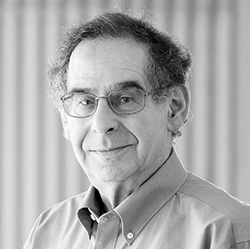G. Steven Martin

Professor Emeritus of Cell Biology, Development and Physiology*
*Affiliate, Division of Biochemistry and Molecular Biology
Research Interests
My research interests developed out of my initial identification of the transforming gene of the retrovirus Rous sarcoma virus, and the finding that this gene, the v-src gene, is both necessary and sufficient for transformation. Much of my subsequent work, and that of my group, was concerned with genetic characterization of v-src function and with biochemical characterization of the signaling pathways activated by v-src that lead to autonomous growth, morphological change and malignant transformation. This in turn led us to study processes of signal transduction and cell cycle regulation in normal cells.
In the area of retrovirology and Src function my research over the years was concerned with the identification of substrates of Src tyrosine phosphorylation; the use of host-range mutants of src to define the function of the Src homology domains and signaling pathways involved in transformation; the characterization of pro- and anti-apoptotic signals generated by v-Src; the roles of ERK5, Rho-GTPases and atypical PKCs in podosome induction by Src; and the effects of lipid modification and SH2 domain-mediated interactions on the mobility of Src in the plasma membrane. We also worked on the identification of other retroviral transforming proteins and replicative gene products and the mechanism of Myc oncogene addiction.
In the second area, signal transduction and cell cycle regulation, my research on mammalian cells was centered round the regulation of signaling proteins downstream from receptor and non-receptor tyrosine kinases. For example we studied the regulation of MAP kinase by protein kinase C and at the onset of meiosis, and identified and structurally characterized a novel effector of the Ras oncoprotein, the Ral guanine nucleotide dissociation stimulator. In addition a diversion into work with budding and fission yeasts led to work on tyrosine phosphorylation and dual specific kinases in budding yeast and the demonstration that the Cdc18 protein of fission yeast couples S-phase to mitosis and to the cell-cycle commitment point, Start.
Current Projects
I retired in 2016 and my lab is now closed; thus I am no longer accepting students or postdoctoral or visiting fellows. However I retain an interest in the exciting research being done in the department and continue to attend faculty seminars. I also offer a freshman seminar, “Museums of the Bay Area,” to introduce new students to some of the rich museum resources of the Bay Area and help them develop their skills in making presentations and in leading and participating in discussions.
Selected Publications
A prudent path forward for genomic engineering and germline gene modification. D. Baltimore, P. Berg, M. Botchan, D. Carroll, R.A. Charo, G. Church, J. Corn, G.Q. Daley, J.A. Doudna, M. Fenner, H.T. Greely, M. Jinek, G.S. Martin, E. Penhoet, J. Puck, S.H. Sternberg, J.S. Weissman, and K.R. Yamamoto (2015). Science 348, 36-38.
Src-mediated caveolin-1 phosphorylation affects the targeting of active Src to specific membrane sites. E. Gottlieb-Abraham, D.E. Shvartsman, J.C.Donaldson, M. Ehrlich, O. Gutman, G.S. Martin, and Y.I. Henis (2013). Mol. Biol. Cell. 24:3881-95.
P27KIP1 mediates addiction of ovarian cancer cells to MYCC (C-MYC) and their dependence on MYC paralogs. T. Prathapam, A. Aleshin, Y. Guan, J.W. Gray, and G.S. Martin (2010). J. Biol. Chem. 285: 32529-38.
Atypical protein kinase C activity is required for the migratory and invasive properties of Src-transformed cells. E. Rodriguez, E.E. Dunham, and G.S. Martin (2009). J Cell Physiol. 221: 171–182.
ERK5 promotes Src-induced podosome formation by limiting Rho activation. M. Schramp, O. Ying, and G.S, Martin (2008). J Cell Biol. 181: 1195-1210.
Src kinase activity and SH2 domain regulate the dynamics of Src association with lipid and protein targets. D.E. Shvartsman, J.C. Donaldson, B. Diaz, O. Gutman, G.S. Martin, and Y.I. Henis (2007). J. Cell Biol. 178: 675-686.
Activated Src abrogates the Myc requirement for the G0/G1 transition but not for the G1/S transition. T. Prathapam, S. Tegen, T. Oskarsson, A. Trumpp and G.S. Martin (2006). Proc. Natl. Acad. Sci. USA 103, 2695-2700,
The road to Src. G.S. Martin (2004). Oncogene 23, 7910-7917.
Active Rho is localized to podosomes induced by oncogenic Src and is required for their assembly and function. R. Berdeaux, B. Diaz, L.C. Kim, A. Tu and G.S. Martin (2004). J. Cell Biol. 166, 317-323.
The hunting of the Src. G.S. Martin (2001). Nature Rev. Mol. Cell Biol. 2, 467-475.
Last Updated 2020-09-10